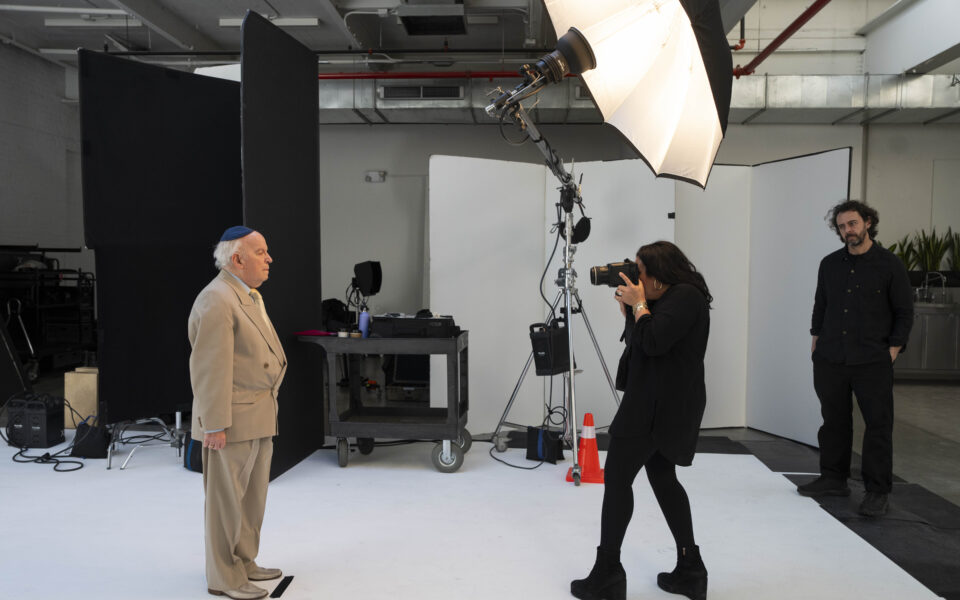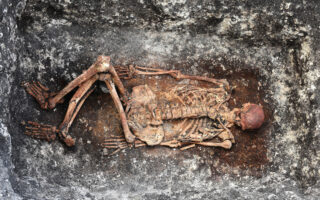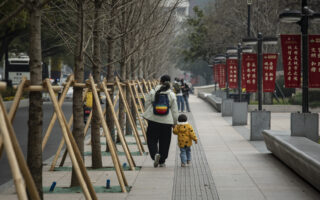Photographing the last of the Holocaust survivors

NEW YORK – Rabbi Aliza Erber, 80, stood at the edge of a pier in lower Manhattan and told those around her to draw closer – and to look out toward the Brooklyn Bridge.
A few seconds later, there it was: a portrait of her face projected onto the bridge, against the backdrop of the Brooklyn skyline, along with her own words. “It was not okay then, it’s not okay now.”
She took in the moment, mesmerized. “That’s me,” she said, her eyes shining. “That’s me.”
Erber is a Holocaust survivor who was hidden in a forest in the Netherlands as a baby during World War II.
Standing alongside her Saturday evening was Gillian Laub, a multimedia artist, who had orchestrated a sweeping public art project that unfurled across Manhattan and Brooklyn.
Using projectors positioned at strategic spots, Laub, who is best known for her photography, arranged for her portraits of Holocaust survivors to be displayed on the facades of buildings and landmark structures.
Laub and her team hoped New York City would wear these faces like an ephemeral veil for much of the night.
The project, called Live2Tell, centers on Laub’s new and expanding photo archive of survivors. She has made more than 200 portraits so far, with plans for more. She and her collaborators picked January 27, the United Nations’ designated International Holocaust Remembrance Day, to draw public attention to the project.
In addition to the photos were quotations from the survivors: “Every person saved is a whole world,” were the words accompanying the portrait of Faye Tzippy Rapaport-Holand, for instance. But there were no captions that identified the faces as those of Holocaust survivors.
“I want anyone who looks at these people being projected to just see the person, the humanity,” said Laub, 48. She hoped that those who were curious to know more would find the Live2Tell Instagram page – especially young people, who Laub believes know the least about the history of the Jews before and during World War II.
Her project comes as the number of Holocaust survivors worldwide – now estimated at 245,000 – is dwindling. Since Laub began shooting these portraits last fall, at least one of her subjects has died, she said.
The project began in late October when Laub was asked by the Auschwitz Jewish Center Foundation to photograph a group of Holocaust survivors who would be coming together at the Museum of Jewish Heritage in lower Manhattan.
She decided to photograph the survivors individually, against a spare white background. Her creative inspiration was Richard Avedon’s portraits of Allen Ginsberg’s family, which he photographed in 1970 and became part of his “Murals” series.
Laub’s projects tend to start small(ish) and then grow in scope. In 2002, she was sent by Spin magazine to photograph homecoming dance rituals in the South. In Montgomery County, Georgia, Laub was shocked to learn that school dances there were racially segregated. She returned repeatedly to document the community and her work spawned a New York Times Magazine photo essay, an HBO documentary, a book and a traveling museum exhibit.
Beginning in 2002, she spent several months every year, for four years, in Israel and the West Bank, which resulted in the 2007 book, “Testimony,” featuring portraits of Israeli Jews, Israeli Arabs and Palestinians.
Her one-day photo shoot of survivors last fall would also grow in breadth. She decided to continue photographing survivors and add video interviews. She imagined turning the images into a mural – perhaps as “an outdoor art installation wrapped around an old synagogue on the Lower East Side” – but was warned by a friend that she risked her project being vandalized.
“You can’t do that,” Laub said the friend told her. “The mural is going to be defaced. You have to honor these people. You can’t let them be defaced.”
Given the public tension over the posters of people kidnapped from Israel playing out on city streets at the time, she agreed, and realized she needed to pivot. Her friend suggested projecting images of the portraits onto buildings. “No one will be able to take them down.”
Many of Laub’s collaborators donated their time to the project, but there were still significant costs. A Jewish nonprofit called Reboot became a fiscal sponsor, which allowed people to make tax-deductible donations. The project received $125,000 to cover the cost of the projections, from a donor who, Laub said, wishes to remain anonymous. Friends, family and collectors of Laub’s work also donated.
To choose locations in New York for projecting the portraits and to handle the associated technical and logistical aspects, Laub enlisted the help of Seth Kirby and Jason Batcheller, who operate the company Production Triangle. They have worked on projections for Metallica and the Met Gala.
“Wizards,” Laub calls them.
Kirby and Batcheller mapped spots around the city where they could project onto highly visible, flat and windowless surfaces.
Batcheller said they consulted city and state government contacts, but no one was certain if there were any legal concerns because they were not posting physical signs and were not advertising a commercial product.
“This is a very gray area,” Kirby said.
“In the past we’ve kind of just done it and asked for forgiveness later,” Batcheller added.
In the meantime, Laub continued making portraits. In mid-November, she photographed more than 100 survivors at a studio in Brooklyn. Two Russian translators volunteered their services. A friend of Laub’s who speaks Yiddish also came to help.
Earlier this month, she photographed another 11.
Asher Matathias, 80, brought a large poster that showed his family history – from his hiding from Nazis in a cave in Greece to immigrating to the United States in 1956.
Esther Berger, 81, and Dr Joseph Berger, 86, were photographed that day too. They were both imprisoned as children at the Bergen-Belsen concentration camp and then met as young adults in Israel and married in 1966.
For the shoot, Esther Berger dressed in a bright pink sweater, but she also brought a second outfit option in a bag. “What you are wearing is absolutely perfect,” Laub assured her.
Anna Malkina, who was born in Russia in 1937 and survived after being hidden first in a bomb shelter by her father and then by a non-Jewish family, stood in front of a camera and belted out “God Bless America,” with her high note at the end drowned out by the applause of Laub and her team.
“This is my favorite,” Malkina said of the song.
In early January, Laub, Kirby and Batcheller went on a test run. As they projected images onto the Brooklyn-Battery Tunnel’s Manhattan entrance, police officers nearby took note and asked them to leave, which they did.
The project is “a bit of a caper,” Kirby said.
But Saturday, the first projections of the night – not only on the Brooklyn Bridge, but in nearly 20 locations – appeared to go smoothly. Several survivors and their relatives joined Laub at a pier in lower Manhattan where they would have a good view of the Brooklyn Bridge projections.
“I wish my mom was here,” Erber said.
Born in the Netherlands after the German invasion, Erber was separated from her mother when, she said, a doctor agreed to keep her and nine other babies in hiding underground. They lived in what she described as a makeshift bunker without windows or doors, beneath woods that were patrolled by Nazi soldiers. She and her mother were eventually reunited, and they immigrated to Israel before she moved to the United States.
Today, she said, she felt an obligation to tell her story. “We are the last link in this horrible chain,” she said. “It’s the reason I speak as much as I do.”
Laub, buzzing with nervous anticipation, finally breathed a sigh of relief at the sight of the first projections. Erber, still teary, hugged the artist, who felt equally grateful.
“Thank you for trusting me,” Laub said, clasping the rabbi’s hand.
This article originally appeared in The New York Times.






